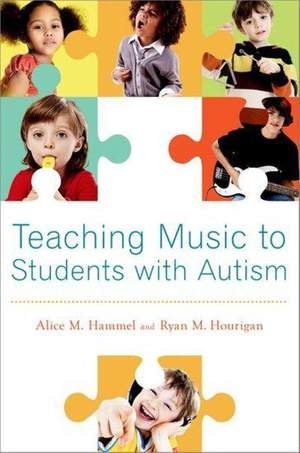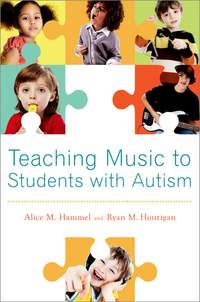Teaching Music to Students with Autism
- Author: Hammel, Alice M.
- Author: Hourigan, Ryan
A helpful support for those needing encouragement and a general resource for those wishing to communicate more effectively with parents, colleagues, and administration in order to help students... — More…
Book
$182.75Special import
Contents
- Foreword by Marilyn Friend
- Chapter 1
- What is Autism? An Explanation of the Diagnosis
- Autism Spectrum Disorders: Diagnostic Information
- Change in Diagnostic Criteria
- Characteristics or Features of Autism
- How do I know I am Teaching a Student with Autism?
- Early Intervention
- Typical Interventions and Treatment Models
- Applied Behavior Analysis and Discrete Trial Training (ABA)
- Treatment and Education of Autistic and Related Communication-Handicapped Children (TEACCH) Curriculum
- DIR/Floortime
- Cognitive Coaching
- Social Stories
- Conclusion
- Discussion Questions
- Chapter 2
- A Team Approach to Teaching Music to Students with Autism
- Learning about your Student (s) with Autism
- Learning about other Educators and Therapists, and Professionals in the District
- Building Relationships with Parents
- Building Relationships with other Staff Members
- Administrative Support
- Participation in Meetings
- Understanding the Least Restrictive Environment and a Student with Autism
- A Student Profile Revisited
- Conclusion
- Discussion Questions and Suggested Activities:
- Chapter 3
- Understanding Communication and Students with Autism
- in the Music Classroom
- Unique Communication Characteristics of Persons with Autism
- Complications with Eye Gaze or Eye Contact
- Eye Contact and Theory of Mind
- Inattentiveness and Eye Contact
- Echolalia
- Joint Attention
- Receptive and Expressive Language Skills
- Receptive Language
- Expressive Language Development (Cause and Effect)
- Strategies for Music Educators in Expressive and Receptive Language
- Steps to Affective Communication with Students with Autism in the Music Classroom
- Step 1-Eye Contact
- Step 2-Joint Attention
- Step 3-Reciprocation
- Augmentative and Alternative Communication (AAC) for Students with Autism
- Communication Interruptions (a failure to communicate)
- Social Stories
- Conclusion
- Discussion Questions
- Chapter 4
- Understanding Cognition and Students with Autism in the Music Classroom
- Theory of Mind and Cognition
- Weak Central Coherence
- Strategies for Assisting with Central Coherence Challenges in the Music Classroom
- Executive Function
- Joint Attention (as it relates to cognition)
- Musical Cognition, Perception, and Response in Students with Autism
- Conclusion
- Discussion Questions:
- Chapter 5
- Classroom Behavior and Students with Autism
- Child Behavior Development and Students with Autism
- Understanding Applied Behavior Analysis (ABA) and Discrete Trial Training (DTT)
- Outbursts, Meltdowns, and other Disruptions
- The Antecedent
- The Behavior
- The Consequence of the Behavior
- Odd or Repetitive Behavior
- Behavior and Communication
- Schedule, Routine and the Link with Behavior
- Creating a Behavior Plan for Students with Autism
- Social Skills and Behavior
- Related Medical Issues and Behavior
- Conclusion: Assessment of Behavior (taking data for the IEP)
- Discussion Questions:
- Chapter 6
- Understanding Socialization of Students with Autism in the Music Classroom
- The Fundamentals of Social Development and Children with Autism
- Gaze/eye-contact and Joint Attention and Socialization
- Extending Eye Contact and Joint Attention in the Music Classroom
- Social Speech and Social Play
- Social Speech and Social Play in the Music Classroom
- Affective Development
- Affective Development in the Music Classroom
- Imitation
- Peer Relationships and Social Interaction
- Peers Relationships and Social Interaction in the Music Classroom
- Reverse Inclusion
- Conclusion
- Discussion Questions
- Chapter 7
- Autism, Sensory Dysfunction, and Music Education
- Tactile Challenges in the Music Classroom
- Vestibular and Proprioceptive Challenges in the Music Classroom
- Visual Dysfunction
- Auditory Sensitivity and Dysfunction
- Sensory Motor/Motor Planning/Dyspraxia
- Sensory Breaks (Conclusion)
- Discussion Questions
- Chapter 8
- Advocacy for Students with Autism in Music Education
- Fostering Relationships with All Stakeholders
- Parents
- Special Education Administrators
- Classroom Teachers
- Conditions for Music Learning for Students with Autism
- Learning Environment
- One-on-one Support
- Multiple Ways to Demonstrate Knowledge
- Teacher Qualities that Must Exist in Music Classrooms
- Local Community Not for Profit Organizations
- Public Informances Including Students with Autism
- Student Support and Awareness Groups
- Conclusion
- Discussion Questions:
- Chapter 9
- Classroom and Ensemble Snapshots of Teaching Music to Students with Autism
- Classroom-based Examples of Teaching Music to Students with Autism
- Performance-based Examples of Teaching Music to Students
- Conclusion
- Chapter 10
- Resources for Music Teachers in Teaching Music to Students with Autism
- Section 1: Internet Resources
- Internet Resources Pertaining to Persons with Autism
- Online Autism Communities
- Autism Apps
- Internet Resources Pertaining to Persons with Asperger Syndrome
- Internet Resources Pertaining to Persons with Rett Syndrome
- Section 2: Print Resources for Music Educators and Music Teacher Educators
- Research within music education pertaining to students with autism
- Dissertations within Music Education and Music Therap
- Books Within Music Therapy and Music Education
- Books Within General Education
- Practitioner Articles Within Music Education
- About the Authors
- Index




